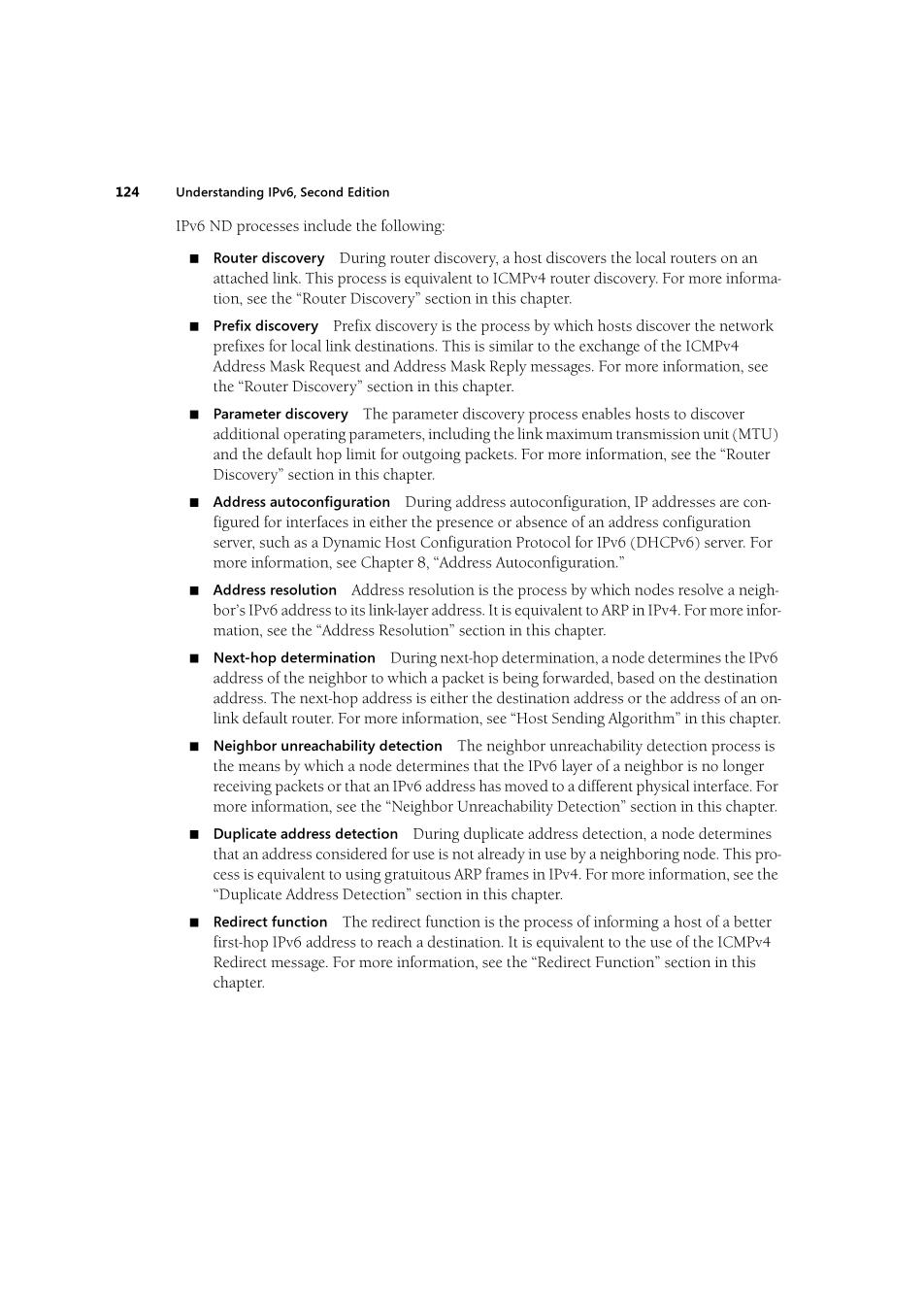正在加载图片...

124 Understanding IPv6,Second Edition IPv6 ND processes include the following: Router discovery During router discovery,a host discovers the local routers on an attached link.This process is equivalent to ICMPv4 router discovery.For more informa- tion,see the "Router Discovery"section in this chapter. Prefix discovery Prefix discovery is the process by which hosts discover the network prefixes for local link destinations.This is similar to the exchange of the ICMPv4 Address Mask Request and Address Mask Reply messages.For more information,see the "Router Discovery"section in this chapter. Parameter discovery The parameter discovery process enables hosts to discover additional operating parameters,including the link maximum transmission unit(MTU) and the default hop limit for outgoing packets.For more information,see the"Router Discovery"section in this chapter. Address autoconfiguration During address autoconfiguration,IP addresses are con- figured for interfaces in either the presence or absence of an address configuration server,such as a Dynamic Host Configuration Protocol for IPv6(DHCPv6)server.For more information,see Chapter 8,"Address Autoconfiguration." Address resolution Address resolution is the process by which nodes resolve a neigh- bor's IPv6 address to its link-layer address.It is equivalent to ARP in IPv4.For more infor- mation,see the "Address Resolution"section in this chapter. Next-hop determination During next-hop determination,a node determines the IPv6 address of the neighbor to which a packet is being forwarded,based on the destination address.The next-hop address is either the destination address or the address of an on- link default router.For more information,see "Host Sending Algorithm"in this chapter. Neighbor unreachability detection The neighbor unreachability detection process is the means by which a node determines that the IPv6 layer of a neighbor is no longer receiving packets or that an IPv6 address has moved to a different physical interface.For more information,see the "Neighbor Unreachability Detection"section in this chapter. Duplicate address detection During duplicate address detection,a node determines that an address considered for use is not already in use by a neighboring node.This pro- cess is equivalent to using gratuitous ARP frames in IPv4.For more information,see the "Duplicate Address Detection"section in this chapter. Redirect function The redirect function is the process of informing a host of a better first-hop IPv6 address to reach a destination.It is equivalent to the use of the ICMPv4 Redirect message.For more information,see the"Redirect Function"section in this chapter.
!"##"#$%!&'(")*"+ && ,$%-. / 01
2
' $%- ')" ($#! " 345* #)($#! " #)*"& !5& ')" # %5% 5))5!*"(&$%678*$#
!"##$#"9'$5&"%)) :;< ')" ($#! " 37= > "$%+ >5? )$ %4#"")*"@A ')"
$#! " 3B#"!)$ %$%)*$#!*5
)" 7 / C
D
2 "+$E($#! " 3$#)*"
!"##F3,*$!** #)#($#! " )*"%"), 6
"+$E"#+ & !5&&$%6("#)$%5)$ %#78*$#$##$>$&5 ) )*""E!*5%-" +)*":;< G(( "##;5#6A"9'"#)5%(G(( "##;5#6A"
&3>"##5-"#7= > "$%+ >5)$ %4#"" )*"@A ')"
$#! " 3B#"!)$ %$%)*$#!*5
)" 7 /
H
2 8*"
5 5>")" ($#! " 3
!"##"%5F&"#* #)#) ($#! " 5(($)$ %5&
" 5)$%-
5 5>")" #4$%!&'($%-)*"&$%6>5E$>'>) 5%#>$##$ %'%$)I;8JK 5%()*"("+5'&)*
&$>$)+ ')- $%-
5!6")#7= > "$%+ >5)$ %4#"")*"@A ')"
$#! " 3B#"!)$ %$%)*$#!*5
)" 7 / L
1 C
1
' $%-5(( "##5') ! %+$-' 5)$ %45(( "##"#5 "! %? +$-' "(+ $%)" +5!"#$%"$)*" )*"
"#"%!" 5F#"%!" +5%5(( "##! %+$-' 5)$ % #" " 4#'!*5#5
3%5>$!M #): %+$-' 5)$ % ) ! &+ I
M:K#" " 7= > "$%+ >5)$ %4#"":*5
)" N4@G(( "##G') ! %+$-' 5)$ %7B / L O1
G(( "## "# &')$ %$#)*"
!"##F3,*$!*% ("# "# &"5%"$-*? F P#5(( "##) $)#&$%6?&53" 5(( "##7)$#"9'$5&"%)) GA$%<7= > "$%+ ? >5)$ %4#"")*"@G(( "##A"# &')$ %B#"!)$ %$%)*$#!*5
)" 7 / QD RST H
' $%-%"E)?*
(")" >$%5)$ %45% ("(")" >$%"#)*" 5(( "## +)*"%"$-*F ) ,*$!*5
5!6")$#F"$%-+ ,5 ("(4F5#"( %)*"("#)$%5)$ % 5(( "##78*"%"E)?*
5(( "##$#"$)*" )*"("#)$%5)$ %5(( "## )*"5(( "## +5% %? &$%6("+5'&) ')" 7= > "$%+ >5)$ %4#""@M #)U"%($%-G&- $)*>B$%)*$#!*5
)" 7 / Q
SV1
S
V
O
2
8*"%"$-*F '% "5!*5F$&$)3(")"!)$ %
!"##$# )*">"5%#F3,*$!*5% ("(")" >$%"#)*5))*"&53" +5%"$-*F $#% & %-" "!"$$%-
5!6")# )*5)5%5(( "##*5#> "() 5($++" "%)
*3#$!5&$%)" +5!"7= > "$%+ >5)$ %4#"")*"@
"$-*F J% "5!*5F$&$)3
")"!)$ %B#"!)$ %$%)*$#!*5
)" 7 / W1TO
' $%-('
&$!5)"5(( "##(")"!)$ %45% ("(")" >$%"# )*5)5%5(( "##! %#$(" "(+ '#"$#% )5& "5(3$%'#"F35%"$-*F $%-% ("78*$#
? !"##$#"9'$5&"%)) '#$%-- 5)'$) '#GA+ 5>"#$%<7= > "$%+ >5)$ %4#"")*" @
'
&$!5)"G(( "##
")"!)$ %B#"!)$ %$%)*$#!*5
)" 7 / 0
C1
8*" "($ "!)+'%!)$ %$#)*"
!"## +$%+ >$%-5* #) +5F"))" +$ #)?*
5(( "##) "5!*5("#)$%5)$ %7)$#"9'$5&"%)) )*"'#" +)*":;< A"($ "!)>"##5-"7= > "$%+ >5)$ %4#"")*"@A"($ "!)='%!)$ %B#"!)$ %$%)*$# !*5
)" 7��